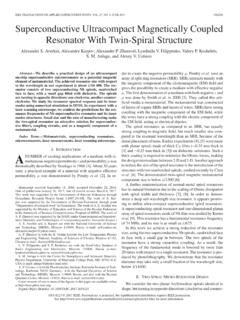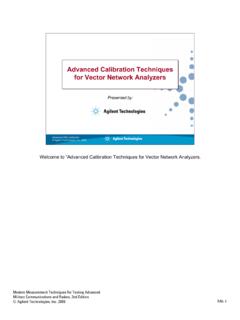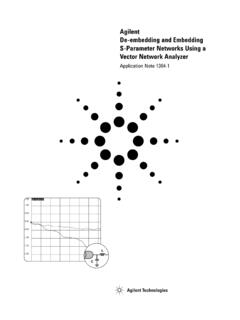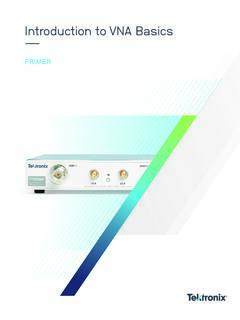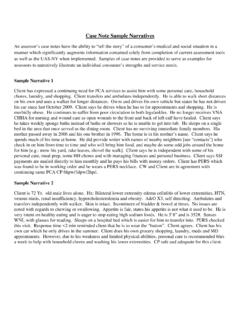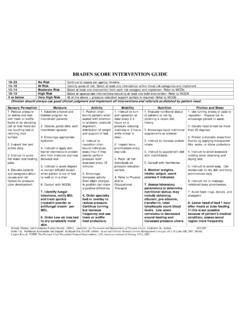Transcription of Understanding VNA Calibration - UMD
1 VNA Calibration1| Understanding VNA calibrationTable of ContentsCalibration 2 Calibration Summary .. 2 Calibration 3 Configuring the 4 Frequency Start, Stop and Number of Points .. 4IF Bandwidth and Averaging .. 4 Point-by-point versus sweep-by-sweep Averaging .. 4 Power .. 4 Types of 5 Full 2-port .. 5 Full 1-port .. 51-path 2-port (forward or reverse) .. 5 Frequency Response (reflection response and transmission-frequency response) .. 5 Line Types .. 7 Calibration Kits .. 9 SOLT Kits .. 9 Kits with Triple-Offset Shorts .. 10 LRL Kits.
2 10 Microstrip & Coplanar Waveguide Kits for the Universal Test Fixture .. 11On Wafer Calibration Kits .. 11 Automatic Calibration (AutoCal) .. 12 Precision AutoCal Calibration Module .. 12 Physical Setup .. 14 Other AutoCal Topics .. 14 Thru Type .. 14 AutoCal Assurance .. 14 Test Port Converters .. 14 Chartacterization .. 15 Nojn-insertable Measurements .. 16 Calibration Model Accuracy .. 16 Triple Offset Short .. 19 Offset Short .. 19 SOLR (Unknown Thru Approach).. 21 LRL/LRM/ALRM .. 23 Isolation .. 28 Adapter Removal .. 29 Thru Update.
3 31 Interpolation .. 31 Calibration Merge .. 32 Network Extraction .. this guide, the concept of Calibration is presented and discussed in detail. Specific topicsto be covered include how to configure the VNA for Calibration , types of Calibration andcalibration kits. A minimal amount of Calibration mathematics and theory will also be covered. Calibration Overview Calibration is critical to making good VNA S-parameter measurements. While the VNA is ahighly-linear receiver and has sufficient spectral purity in its sources to make goodmeasurements, there are a number of imperfections that limit measurements done withoutcalibrations.
4 These imperfections include: 1. Match Because the VNA is such a broadband instrument, the raw match is decent butnot excellent. Even a 20-dB match, which is physically very good, can lead to errors ofgreater than 1 dB. Correcting for this raw match greatly reduces the potential error. 2. Directivity A key component of a VNA is a directional coupler. This device allows theinstrument to separate the signal incident on the DUT from the signal reflected back fromthe DUT. While the couplers used in the VNA are of very high quality, there is a certainamount of coupled signal, even when a perfect termination is connected.
5 This is related todirectivity and can impact measurements of very small reflection coefficients. 3. Frequency Response While the internal frequency response of the VNA could becalibrated at the factory, any cables connected externally will have some frequencyresponse that must be calibrated out for high-quality measurements. Calibration Summary Calibration is a tool for correcting for these imperfections, as well as other defects. There arean enormous number of possible Calibration algorithms and many of them are implementedwithin VNAs. The choice between them is largely determined by the media the engineer isworking in, the Calibration standards available and the desired accuracy/ effort trade these choices will be discussed in detail later in this chapter, they can be categorizedaccording to two distinctions: Calibration type ( , which ports are being corrected and towhat level they are being corrected) and Calibration algorithm ( , how the correction isbeing accomplished).
6 A summary of Calibration types is provided in Table | Understanding VNA calibrationTable 1 - This table summarizes the various types of Calibration available to the VNA userCalibration AlgorithmsCalibration algorithms are a forest of acronyms. In literature these acronyms are often timesinconsistent. To add further confusion, the letters may represent different things at differenttimes. Table 3-2 shows the acronyms used in Anritsu documentation and is intended toprovide a representation of the most common usage of algorithm acronyms. Table 2 - This table summarizes the different Calibration algorithms available to the VNA Parameters calibrated UsesFull 2-port Full 1-portS11, S12, S21, and S22 S11 or S22 or S11 and S22 Most complete calibrationReflection only1-port reflection plus simple transmission(faster, lower transmission accuracyunless DUT very lossy)Frequency response1-path 2-portS11 and S21 or S22 and S12 Normalization only.
7 Fast, lower accuracyAny one parameter (or pairs ofsymmetric parameters) Calibration Algorithm Description SOLT (short-open-load-thru) Common coaxiallyCommon in waveguideSimple, redundantstandards; not band limitedSame as SOLTSame as SOLT but better accuracy athigh frequencySSLT (short-short-load-thru), shorts with different offset lengths Common in waveguide or high frequency coaxDoes not requirewell-defined thruLike the above but whena good thru is not availableSSST (Short-short-short-thru), all shorts with differentoffset lengthsSOLR/SSLR/SSSR, like abovebut with reciprocal insteadof thru LRL (Line-reflect-line),also called TRLALRM* (advanced line-reflect-match)
8 , also called TRMR elatively high performanceHigh performance coax,waveguideor on-waferAdvantagesHighest accuracy,minimal standarddefinitionHigh accuracy, only one line length so easier to fixture/on-wafer, not band-limitedusuallyDisadvantagesRequires very well-defined standards,poor on-wafer, lower accuracy at highfrequencySame as SOLT and band-limitedRequires very well-defined standards,poor on-wafer, band-limitedSome accuracy degradation, but slightly less definition, other disadvantages of parent calibrationRequires very good transmission lines,less redundancy so more care isrequired, band-limitedRequires load definition.
9 Reflectstandard setup may requirecare depending on load model used*ALRM is an Anritsu enhancement to standard LRM that includes advanced load-modeling techniques and structures. In itsbasal form of a default-load model, it is conventional LRM. The terms LRM and ALRM are used somewhat interchangeably,except in cases where the load modeling context is important. The VNA Before discussing Calibration further, and some of the alternatives available, it is important tofirst gain a clear Understanding of any VNA setup issues as they will affect calibrationperformance. In almost all cases, the VNA settings are used during Calibration .
10 Therefore,setting up the VNA as desired beforehand can be especially helpful. The settings of interestare: 1. Frequency Start, Stop and Number of Points - These settings are obvious. Segmentedsweep must also be setup in advance if a more custom frequency list is desired. 2. IF Bandwidth and Averaging-These parameters control the digitalfiltering and post processing thatdetermine the effective noise floor,amount of trace noise and, in somespecial cases, immunity to interferingsignals. The trade off for improvednoise performance is slower sweepspeed. Figure 3-1 provides an example oftwo IF-bandwidth settings.
